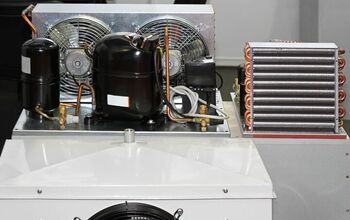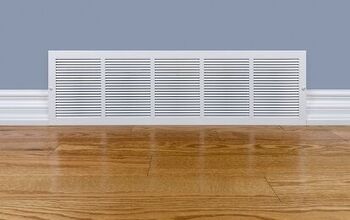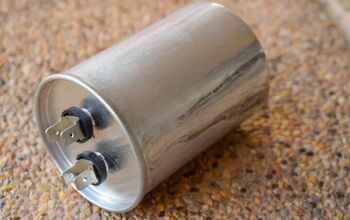How Far Should Your Fridge Stick Out? (Find Out Now!)

A fridge that sticks out too far is an eyesore, and it also makes using your kitchen a bit more difficult. Refrigerator manufacturers determine how much space your fridge needs relative to the walls and cabinets.
Most refrigerators need to be 1” from the back wall and 1/4” from the walls and cabinets on the side. Check the owner’s manual or manufacturer’s website for spacing requirements. Fridges that stick out too far take away floor space and block cabinets. Install a fridge cabinet. Consider a counter-depth fridge to gain floor space and access to cabinets.
There are only a few options for a fridge that sticks out too far. Let’s look at why your fridge needs space, and how you can improve the design of your kitchen.
Do You Need Appliance Installation or Replacement?
Get free, zero-commitment quotes from pro contractors near you.

How Far is Too Far?
The standard spacing for a fridge is 1” from the back wall and 1/4” on both sides. The manufacturer determines the proper spacing for their refrigerators. Check the owner’s manual or manufacturer website for the space requirements of your fridge.
Why Your Fridge Needs Space
Refrigerators work by removing heat from the interior storage space where you keep your food. Refrigerant circulates through the shell of the fridge. Heat from the interior of the fridge is transferred to the refrigerant.
The compressor turns the liquid refrigerant into a gas for efficient heat exchange. During this process, the compressor gets warm, and the heat needs somewhere to go. It is released into the air around your refrigerator.
You need to leave space around your fridge to prevent overheating of the compressor. If the compressor gets too hot, you have a major repair job on your hands, at best. At worst, the entire unit needs to be replaced.
The Problem with a Fridge That Sticks Out Too Far
As practical as it may be to keep your refrigerator at least 1” from the back wall, the spacing affects the aesthetics and flow of your kitchen. A fridge that sticks out too far also affects how well you can use your kitchen.
Opening Drawers and Ovens
If your fridge is installed in a corner with cabinets, you lose access to the drawers and lower cabinets. At a minimum, you have to keep the fridge door closed to use the cabinets and drawers. You simply can’t work efficiently while you are cooking. You have to close the fridge door to open a cabinet or drawer, or you don’t use that storage space in your kitchen.
Room to Walk
A fridge that sticks out too far takes away valuable floor space. Kitchens should have an aisle of 36” or more. If someone in your family has limited mobility and uses a walker or wheelchair, the aisle needs to be at least 40” in work areas. If the appliances are on one side of the kitchen, the aisle should be 36” wide. If you have a U-shaped or L-shaped kitchen with an island, the aisle needs to be 42” so the individual can make the turn in a wheelchair.
Design Flow
Having a fridge that sticks out too far affects the flow of the kitchen design. The fridge is an eyesore that takes centerstage, and your countertops, cabinets, flooring, lighting, and other appliances fall to background. A fridge that sticks out too far does not work with a sleek, modern design. Instead of complementing the design, the fridge works as an awkward break in the otherwise smooth, flowing lines.
Can You Hide a Fridge That Sticks Out Too Far?
One way that you can camouflage a fridge that sticks out too far is with a cabinet. This doesn’t help with access to drawers, cabinets, and ovens. A fridge cabinet does help with design flow and aesthetics. Use the same materials as your cabinets.
Counter-Depth Refrigerators
If your fridge gets in the way of cabinets, drawers, and your oven, consider replacing it with a counter-depth fridge. Counter-depth fridges are not as deep as standard fridges, and the door is nearly flush with your countertop. A counter-depth fridge typically sticks out only 1” to 2” from the edge of the countertop.
Pros of a Counter-Depth Fridge
- Streamlined look
- Easy access to items on the back of the shelves
- Better flow in your kitchen
- Wider kitchen aisle
- Several storage options, such as drawer compartments and door shelves
Cons of a Counter-Depth Fridge
- Wider than standard fridges
- Smaller freezer
- Shallower interior drawers
- Greater door swing
Are Counter-Depth Refrigerators Expensive?
Yes. Counter-depth fridges are more expensive than standard refrigerators. The law of supply and demand applies. Counter-depth fridges are the exception, and not the rule for home appliances. As a result, the cost of production is higher. Counter-top fridges are also considered high-end appliances, just one step below built-in fridges. As such, manufacturers and retailers charge what people are willing to pay.
How to Choose a Counter-Depth Fridge
Standard refrigerators are 30” to 34” deep. A counter-top fridge is 23” to 27” deep. Kitchen counters are about 25.5” deep. Before you buy a counter-deep fridge, take measurements of your countertops. Also, consider how much interior space you will lose by going with a fridge that is not as deep.
With a little research, accurate measurements, and careful consideration, you can find a counter-depth fridge that improves the look and function of your kitchen.
A Note About Built-In Refrigerators
A built-in refrigerator has a longer lifetime than standard fridges, and you can customize the appliance to fit perfectly with our kitchen design. Built-in refrigerators are very expensive. The disadvantage is that you cannot change the layout of your kitchen without major renovations.
If you want a sleek, modern look and don’t plan on changing your kitchen for 5 to 10 years, a built-in fridge is worth considering. Expect to pay $2,900 to $6,200 for the unit and installation. You may incur additional costs if your cabinets need to be modified to fit the refrigerator.
Related Questions
How much interior space do I need for my fridge?
The interior space of a fridge is measured in cubic feet. Start with the cubic feet of your current fridge. If the fridge isn’t labeled, check the manufacturer’s website.For the new fridge, have at least 4 to 6 cubic feet for each person in your household. Add a few more cubic feet to get the baseline. Next, consider how much fresh food you typically store or would like to store in the new fridge. Add 2 to 6 cubic feet is you use a lot of fresh ingredients. For reference, 18 cubic feet is good for two people, and a family of four does well with 20 cubic feet.Freezer space and organization are also important. If you use frozen items frequently, choose a counter-depth fridge with a larger freezer. Door shelves and interior drawers help you organize small items.
How long should a refrigerator last?
Refrigerators last about 12 years. After that, expect to make repairs to keep the fridge working properly.
How do I know when my fridge needs to be replaced?
Humming, buzzing, and other unusual noises are signs that it’s time to replace your fridge. You may also want to replace it if your energy bills are high. A new fridge will be more energy-efficient. You recoup the cost of the fridge in the money that you save each month on your electric bill.
Why does my refrigerator feel warm?
The side of your refrigerator feels warm because it is removing heat from the interior space where you store food. The warmth is generated when the refrigerant absorbs heat from food items.The side of the fridge should only be comfortably warm. If it is hot, this is a sign that the compressor is overheating. Contact a refrigerator technician to have the unit serviced.
Do You Need Appliance Installation or Replacement?
Get free, zero-commitment quotes from pro contractors near you.

What Did We Learn?
Refrigerators should be at least 1” from the back wall and 1/4” from side walls and cabinets. The fridge needs space to prevent overheating of the compressor. If the compressor gets too hot, it will need repairs or replacement.
A fridge that sticks out too far causes several problems. You lose access to neighboring drawers and cabinets. A fridge that sticks out too far disrupts the design flow of the space. You have a narrow kitchen aisle that makes it hard to walk and work in the space, especially if someone in your home has limited mobility.
Camouflage a refrigerator that sticks out too far from the countertop with a fridge cabinet. This fixes the aesthetic problem.
A counter-depth refrigerator corrects the design aesthetic and flow pattern. It also gives you access to your drawers, cabinets, and appliances. Counter-depth fridges are not as deep as standard fridges, but they are wider. Make sure the fridge will fit in the same space as your current fridge.
Choose a counter-depth refrigerator that has enough space inside to store your food items. Make sure that there is enough room in the freezer. Look for space saving features, such as interior drawers and shelves, to keep your ingredients organized.
Related Guide

Jennifer L. Eggerton loves being hands-on, whether it's with a home DIY project, making repairs, re-decorating a room, or keeping life organized. She enjoys helping people by sharing her knowledge, insights, and experiences, as well as her lessons learned. In addition to her work as a writer, Jennifer is a Jeep® overlander, self-published author, and nature photographer who loves being outdoors.
More by Jennifer Eggerton



























